Customer Service Management for Tourism and Hospitality: CRM Report
VerifiedAdded on 2020/05/04
|14
|4300
|63
Report
AI Summary
This report delves into the Customer Relationship Management (CRM) model, focusing on its significance in the tourism and hospitality sector. It begins with an introduction outlining the importance of CRM, particularly in the context of the Natural History Museum (NHM), and its role in fostering customer relationships. The report then provides an in-depth analysis of the CRM model, defining it as a strategic approach to managing customer data and interactions. It explores key components such as human resource management, lead management, customer service, marketing, workflow automation, business reporting, and analytics, highlighting their individual contributions to building and maintaining customer relationships. Furthermore, the report outlines the benefits of CRM, including improved customer relations, increased revenue, upselling and cross-selling opportunities, enhanced internal communication, and optimized marketing strategies. The report also details the implementation process of CRM, including identifying organizational needs, selecting a suitable CRM vendor, developing a budget, and training employees. Overall, the report emphasizes the importance of CRM in enhancing business operations and customer satisfaction within the tourism and hospitality industry.
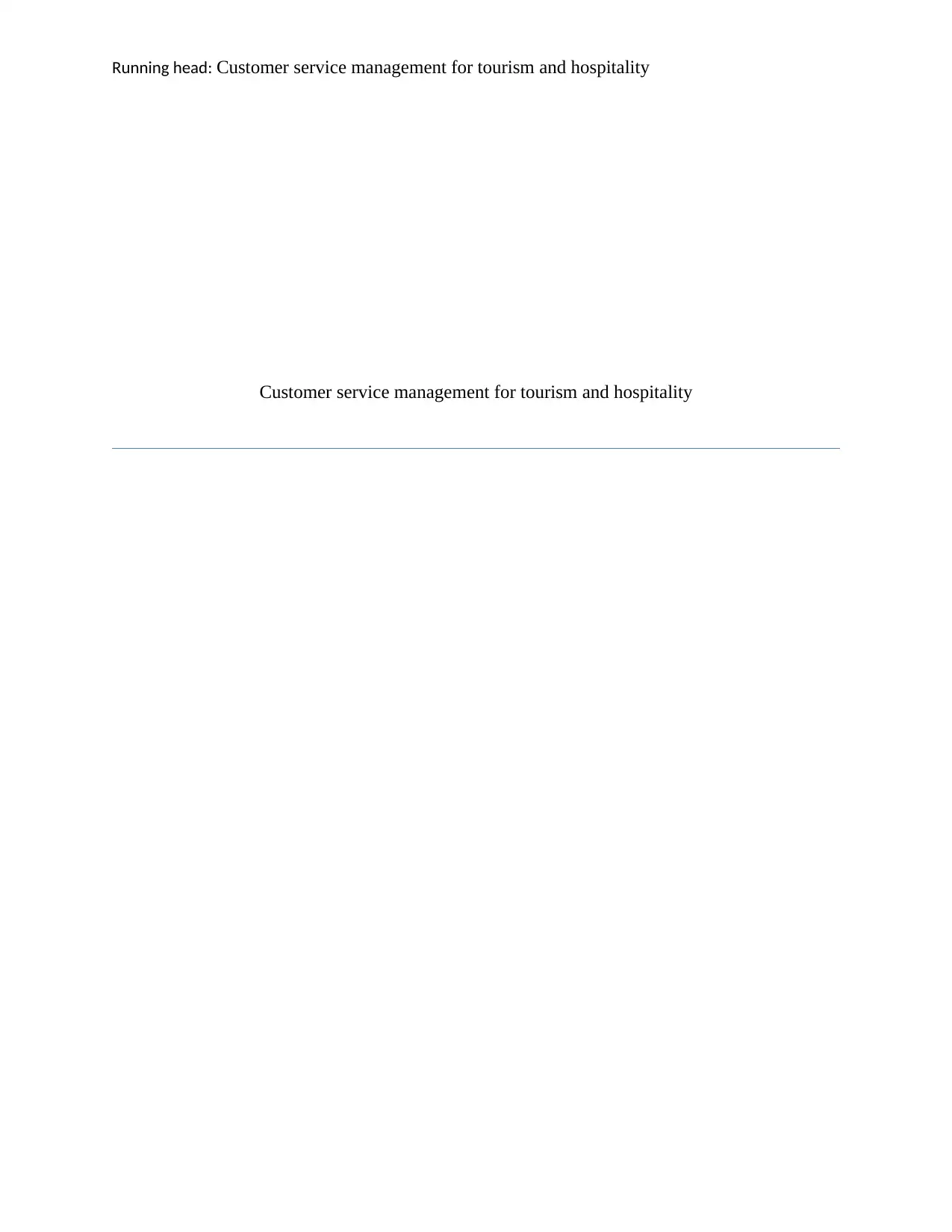
Running head: Customer service management for tourism and hospitality
Customer service management for tourism and hospitality
Customer service management for tourism and hospitality
Paraphrase This Document
Need a fresh take? Get an instant paraphrase of this document with our AI Paraphraser
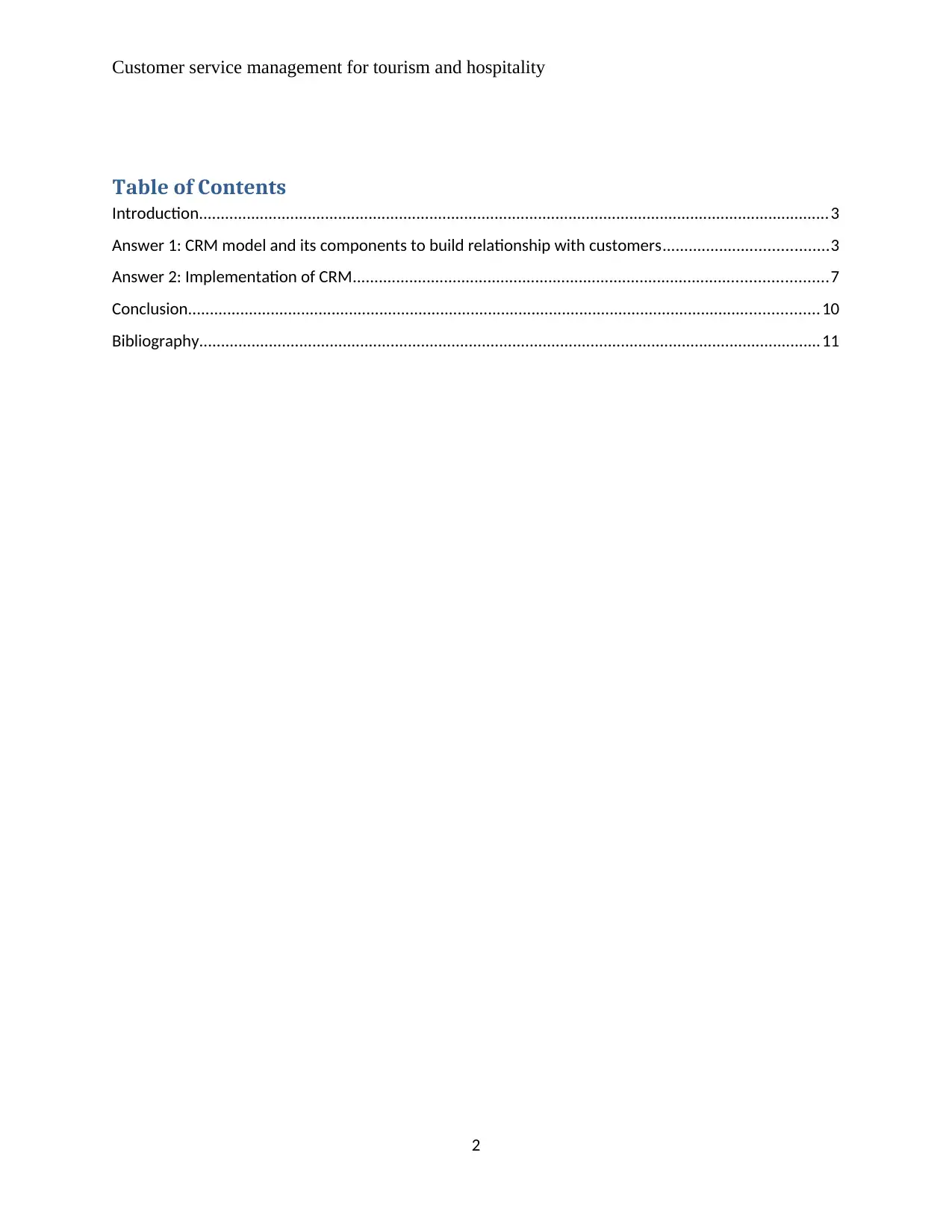
Customer service management for tourism and hospitality
Table of Contents
Introduction.................................................................................................................................................3
Answer 1: CRM model and its components to build relationship with customers......................................3
Answer 2: Implementation of CRM.............................................................................................................7
Conclusion.................................................................................................................................................10
Bibliography...............................................................................................................................................11
2
Table of Contents
Introduction.................................................................................................................................................3
Answer 1: CRM model and its components to build relationship with customers......................................3
Answer 2: Implementation of CRM.............................................................................................................7
Conclusion.................................................................................................................................................10
Bibliography...............................................................................................................................................11
2
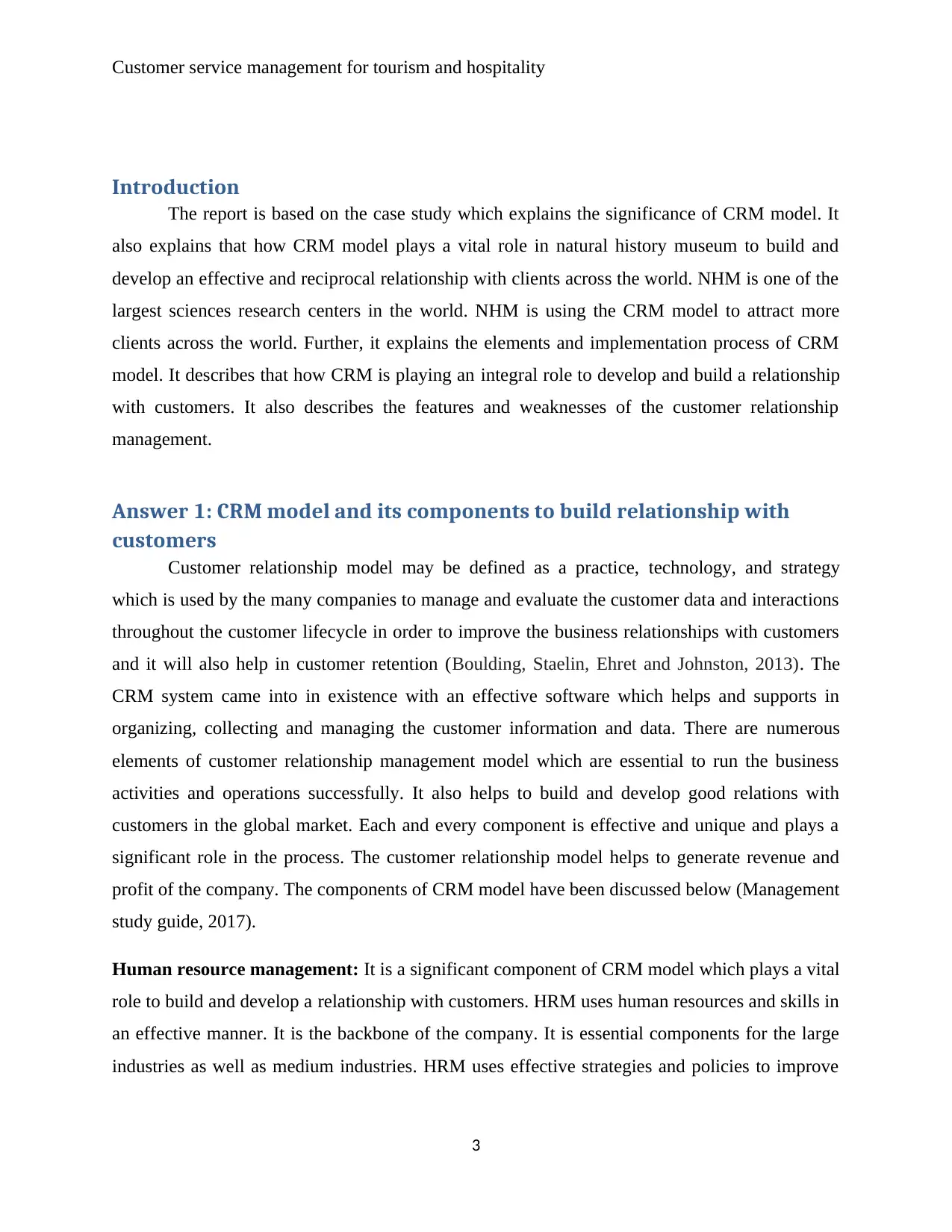
Customer service management for tourism and hospitality
Introduction
The report is based on the case study which explains the significance of CRM model. It
also explains that how CRM model plays a vital role in natural history museum to build and
develop an effective and reciprocal relationship with clients across the world. NHM is one of the
largest sciences research centers in the world. NHM is using the CRM model to attract more
clients across the world. Further, it explains the elements and implementation process of CRM
model. It describes that how CRM is playing an integral role to develop and build a relationship
with customers. It also describes the features and weaknesses of the customer relationship
management.
Answer 1: CRM model and its components to build relationship with
customers
Customer relationship model may be defined as a practice, technology, and strategy
which is used by the many companies to manage and evaluate the customer data and interactions
throughout the customer lifecycle in order to improve the business relationships with customers
and it will also help in customer retention (Boulding, Staelin, Ehret and Johnston, 2013). The
CRM system came into in existence with an effective software which helps and supports in
organizing, collecting and managing the customer information and data. There are numerous
elements of customer relationship management model which are essential to run the business
activities and operations successfully. It also helps to build and develop good relations with
customers in the global market. Each and every component is effective and unique and plays a
significant role in the process. The customer relationship model helps to generate revenue and
profit of the company. The components of CRM model have been discussed below (Management
study guide, 2017).
Human resource management: It is a significant component of CRM model which plays a vital
role to build and develop a relationship with customers. HRM uses human resources and skills in
an effective manner. It is the backbone of the company. It is essential components for the large
industries as well as medium industries. HRM uses effective strategies and policies to improve
3
Introduction
The report is based on the case study which explains the significance of CRM model. It
also explains that how CRM model plays a vital role in natural history museum to build and
develop an effective and reciprocal relationship with clients across the world. NHM is one of the
largest sciences research centers in the world. NHM is using the CRM model to attract more
clients across the world. Further, it explains the elements and implementation process of CRM
model. It describes that how CRM is playing an integral role to develop and build a relationship
with customers. It also describes the features and weaknesses of the customer relationship
management.
Answer 1: CRM model and its components to build relationship with
customers
Customer relationship model may be defined as a practice, technology, and strategy
which is used by the many companies to manage and evaluate the customer data and interactions
throughout the customer lifecycle in order to improve the business relationships with customers
and it will also help in customer retention (Boulding, Staelin, Ehret and Johnston, 2013). The
CRM system came into in existence with an effective software which helps and supports in
organizing, collecting and managing the customer information and data. There are numerous
elements of customer relationship management model which are essential to run the business
activities and operations successfully. It also helps to build and develop good relations with
customers in the global market. Each and every component is effective and unique and plays a
significant role in the process. The customer relationship model helps to generate revenue and
profit of the company. The components of CRM model have been discussed below (Management
study guide, 2017).
Human resource management: It is a significant component of CRM model which plays a vital
role to build and develop a relationship with customers. HRM uses human resources and skills in
an effective manner. It is the backbone of the company. It is essential components for the large
industries as well as medium industries. HRM uses effective strategies and policies to improve
3
⊘ This is a preview!⊘
Do you want full access?
Subscribe today to unlock all pages.

Trusted by 1+ million students worldwide
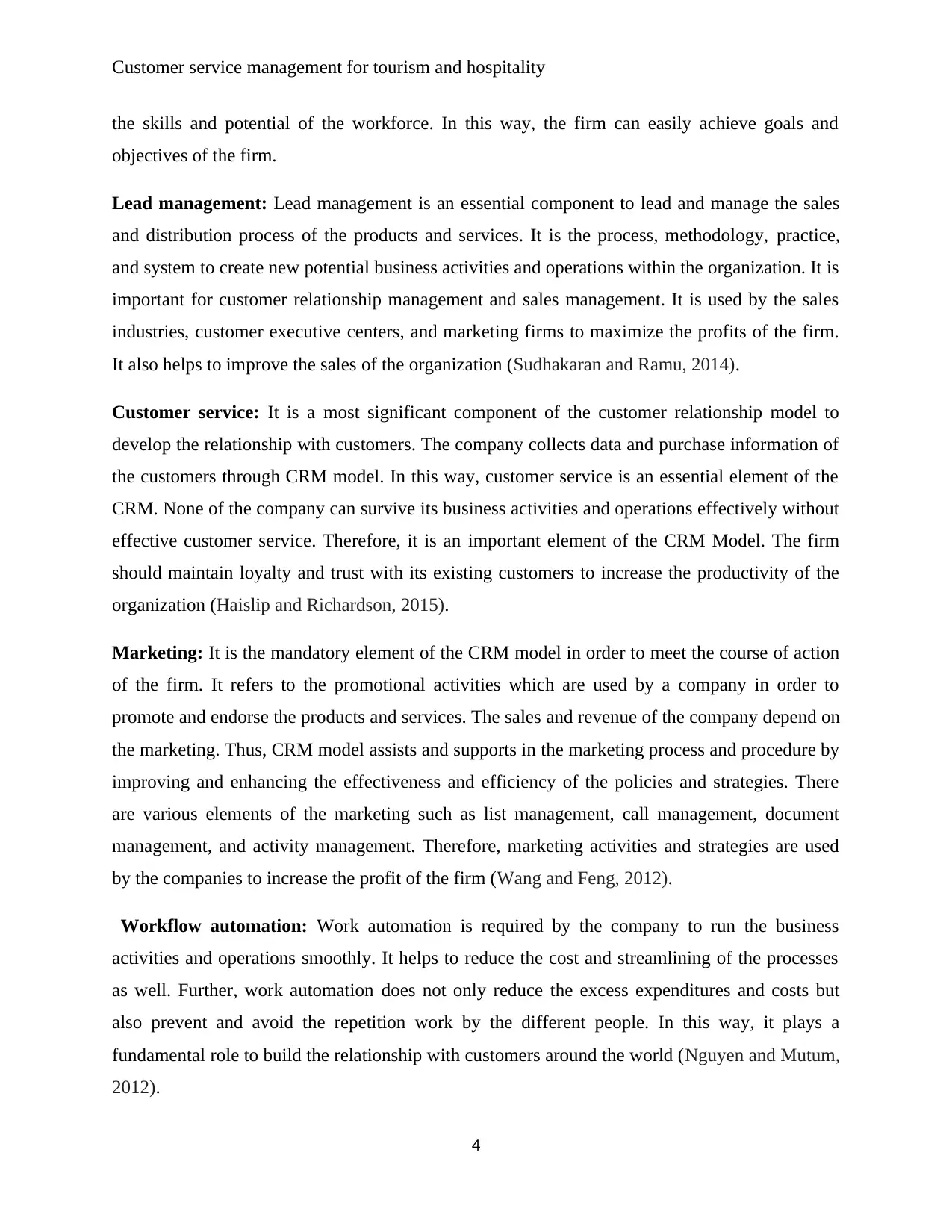
Customer service management for tourism and hospitality
the skills and potential of the workforce. In this way, the firm can easily achieve goals and
objectives of the firm.
Lead management: Lead management is an essential component to lead and manage the sales
and distribution process of the products and services. It is the process, methodology, practice,
and system to create new potential business activities and operations within the organization. It is
important for customer relationship management and sales management. It is used by the sales
industries, customer executive centers, and marketing firms to maximize the profits of the firm.
It also helps to improve the sales of the organization (Sudhakaran and Ramu, 2014).
Customer service: It is a most significant component of the customer relationship model to
develop the relationship with customers. The company collects data and purchase information of
the customers through CRM model. In this way, customer service is an essential element of the
CRM. None of the company can survive its business activities and operations effectively without
effective customer service. Therefore, it is an important element of the CRM Model. The firm
should maintain loyalty and trust with its existing customers to increase the productivity of the
organization (Haislip and Richardson, 2015).
Marketing: It is the mandatory element of the CRM model in order to meet the course of action
of the firm. It refers to the promotional activities which are used by a company in order to
promote and endorse the products and services. The sales and revenue of the company depend on
the marketing. Thus, CRM model assists and supports in the marketing process and procedure by
improving and enhancing the effectiveness and efficiency of the policies and strategies. There
are various elements of the marketing such as list management, call management, document
management, and activity management. Therefore, marketing activities and strategies are used
by the companies to increase the profit of the firm (Wang and Feng, 2012).
Workflow automation: Work automation is required by the company to run the business
activities and operations smoothly. It helps to reduce the cost and streamlining of the processes
as well. Further, work automation does not only reduce the excess expenditures and costs but
also prevent and avoid the repetition work by the different people. In this way, it plays a
fundamental role to build the relationship with customers around the world (Nguyen and Mutum,
2012).
4
the skills and potential of the workforce. In this way, the firm can easily achieve goals and
objectives of the firm.
Lead management: Lead management is an essential component to lead and manage the sales
and distribution process of the products and services. It is the process, methodology, practice,
and system to create new potential business activities and operations within the organization. It is
important for customer relationship management and sales management. It is used by the sales
industries, customer executive centers, and marketing firms to maximize the profits of the firm.
It also helps to improve the sales of the organization (Sudhakaran and Ramu, 2014).
Customer service: It is a most significant component of the customer relationship model to
develop the relationship with customers. The company collects data and purchase information of
the customers through CRM model. In this way, customer service is an essential element of the
CRM. None of the company can survive its business activities and operations effectively without
effective customer service. Therefore, it is an important element of the CRM Model. The firm
should maintain loyalty and trust with its existing customers to increase the productivity of the
organization (Haislip and Richardson, 2015).
Marketing: It is the mandatory element of the CRM model in order to meet the course of action
of the firm. It refers to the promotional activities which are used by a company in order to
promote and endorse the products and services. The sales and revenue of the company depend on
the marketing. Thus, CRM model assists and supports in the marketing process and procedure by
improving and enhancing the effectiveness and efficiency of the policies and strategies. There
are various elements of the marketing such as list management, call management, document
management, and activity management. Therefore, marketing activities and strategies are used
by the companies to increase the profit of the firm (Wang and Feng, 2012).
Workflow automation: Work automation is required by the company to run the business
activities and operations smoothly. It helps to reduce the cost and streamlining of the processes
as well. Further, work automation does not only reduce the excess expenditures and costs but
also prevent and avoid the repetition work by the different people. In this way, it plays a
fundamental role to build the relationship with customers around the world (Nguyen and Mutum,
2012).
4
Paraphrase This Document
Need a fresh take? Get an instant paraphrase of this document with our AI Paraphraser
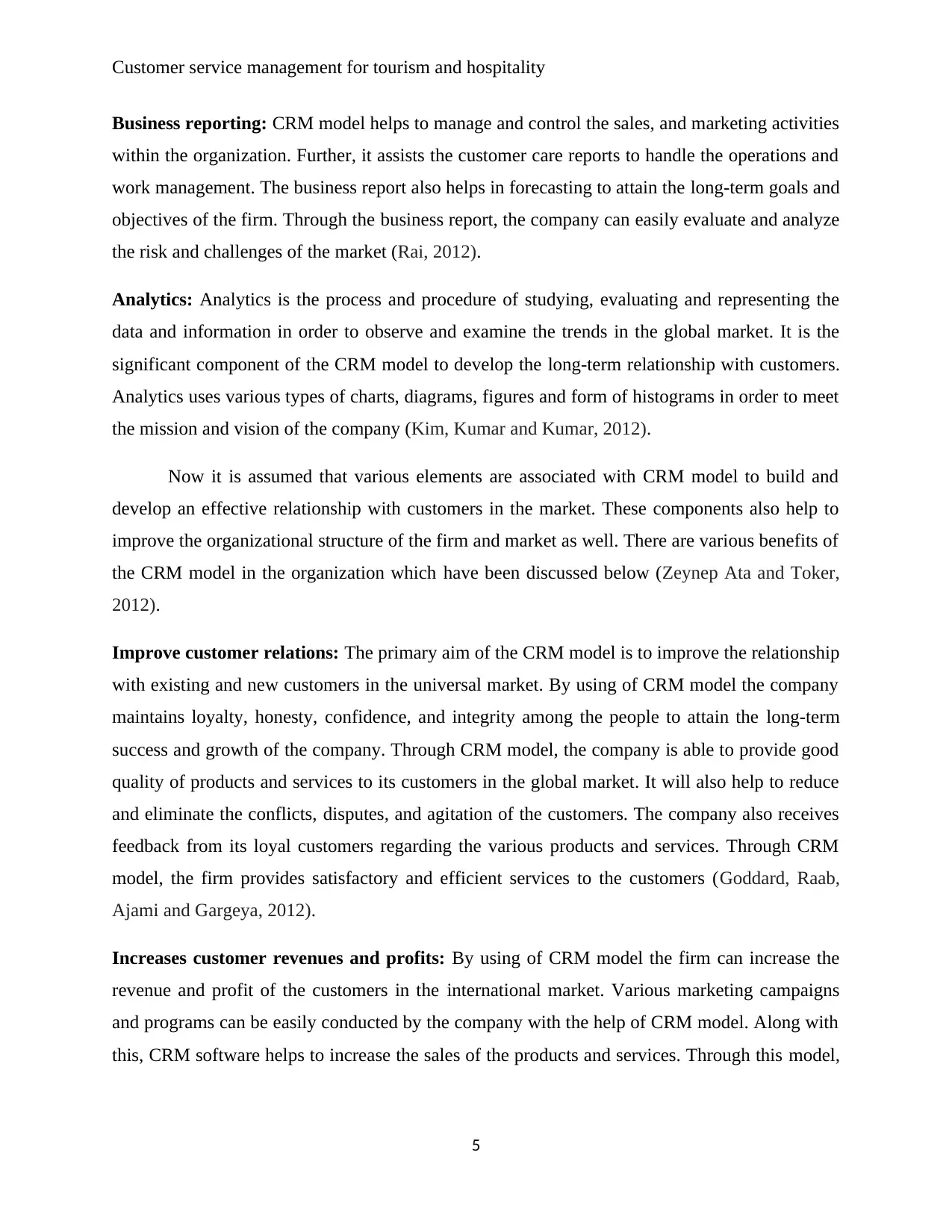
Customer service management for tourism and hospitality
Business reporting: CRM model helps to manage and control the sales, and marketing activities
within the organization. Further, it assists the customer care reports to handle the operations and
work management. The business report also helps in forecasting to attain the long-term goals and
objectives of the firm. Through the business report, the company can easily evaluate and analyze
the risk and challenges of the market (Rai, 2012).
Analytics: Analytics is the process and procedure of studying, evaluating and representing the
data and information in order to observe and examine the trends in the global market. It is the
significant component of the CRM model to develop the long-term relationship with customers.
Analytics uses various types of charts, diagrams, figures and form of histograms in order to meet
the mission and vision of the company (Kim, Kumar and Kumar, 2012).
Now it is assumed that various elements are associated with CRM model to build and
develop an effective relationship with customers in the market. These components also help to
improve the organizational structure of the firm and market as well. There are various benefits of
the CRM model in the organization which have been discussed below (Zeynep Ata and Toker,
2012).
Improve customer relations: The primary aim of the CRM model is to improve the relationship
with existing and new customers in the universal market. By using of CRM model the company
maintains loyalty, honesty, confidence, and integrity among the people to attain the long-term
success and growth of the company. Through CRM model, the company is able to provide good
quality of products and services to its customers in the global market. It will also help to reduce
and eliminate the conflicts, disputes, and agitation of the customers. The company also receives
feedback from its loyal customers regarding the various products and services. Through CRM
model, the firm provides satisfactory and efficient services to the customers (Goddard, Raab,
Ajami and Gargeya, 2012).
Increases customer revenues and profits: By using of CRM model the firm can increase the
revenue and profit of the customers in the international market. Various marketing campaigns
and programs can be easily conducted by the company with the help of CRM model. Along with
this, CRM software helps to increase the sales of the products and services. Through this model,
5
Business reporting: CRM model helps to manage and control the sales, and marketing activities
within the organization. Further, it assists the customer care reports to handle the operations and
work management. The business report also helps in forecasting to attain the long-term goals and
objectives of the firm. Through the business report, the company can easily evaluate and analyze
the risk and challenges of the market (Rai, 2012).
Analytics: Analytics is the process and procedure of studying, evaluating and representing the
data and information in order to observe and examine the trends in the global market. It is the
significant component of the CRM model to develop the long-term relationship with customers.
Analytics uses various types of charts, diagrams, figures and form of histograms in order to meet
the mission and vision of the company (Kim, Kumar and Kumar, 2012).
Now it is assumed that various elements are associated with CRM model to build and
develop an effective relationship with customers in the market. These components also help to
improve the organizational structure of the firm and market as well. There are various benefits of
the CRM model in the organization which have been discussed below (Zeynep Ata and Toker,
2012).
Improve customer relations: The primary aim of the CRM model is to improve the relationship
with existing and new customers in the universal market. By using of CRM model the company
maintains loyalty, honesty, confidence, and integrity among the people to attain the long-term
success and growth of the company. Through CRM model, the company is able to provide good
quality of products and services to its customers in the global market. It will also help to reduce
and eliminate the conflicts, disputes, and agitation of the customers. The company also receives
feedback from its loyal customers regarding the various products and services. Through CRM
model, the firm provides satisfactory and efficient services to the customers (Goddard, Raab,
Ajami and Gargeya, 2012).
Increases customer revenues and profits: By using of CRM model the firm can increase the
revenue and profit of the customers in the international market. Various marketing campaigns
and programs can be easily conducted by the company with the help of CRM model. Along with
this, CRM software helps to increase the sales of the products and services. Through this model,
5
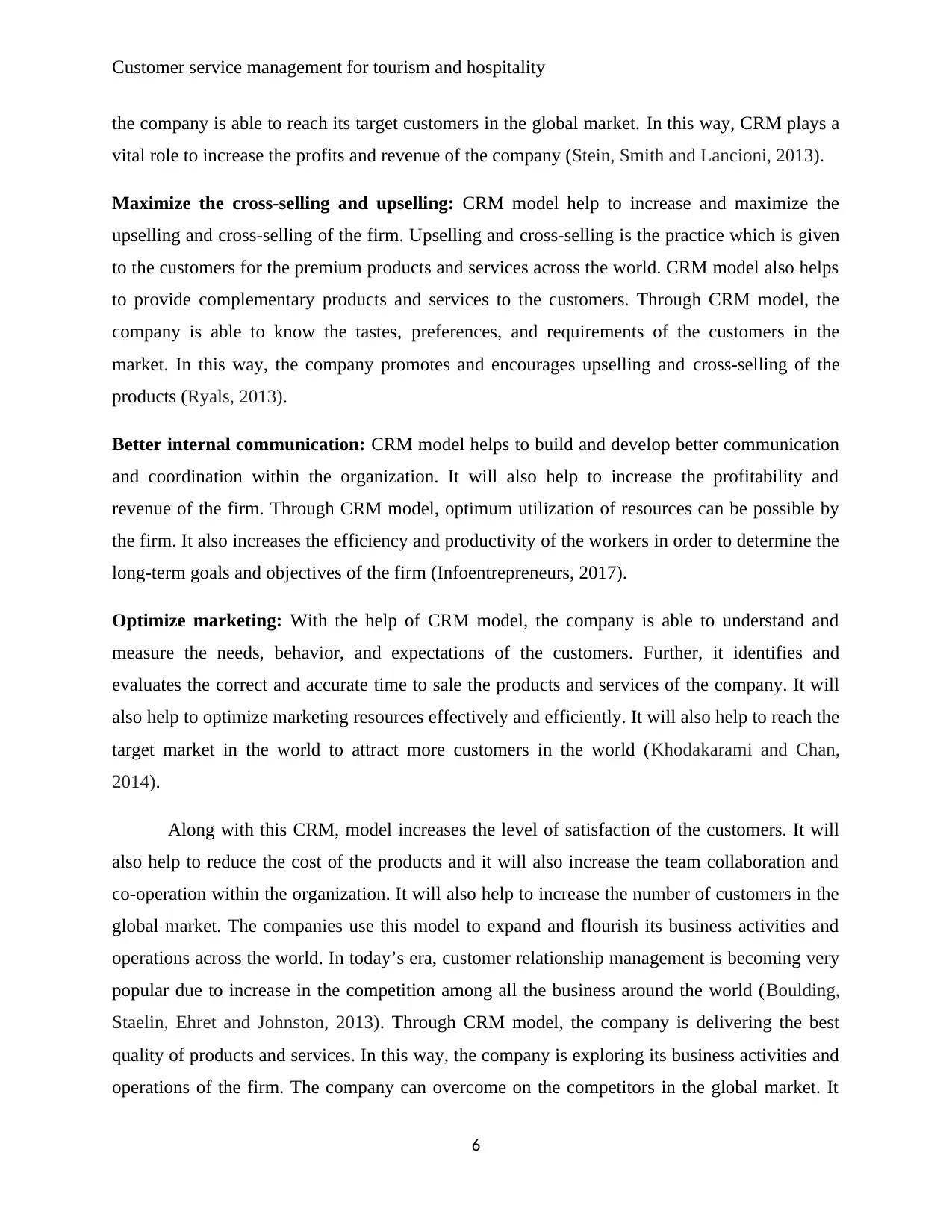
Customer service management for tourism and hospitality
the company is able to reach its target customers in the global market. In this way, CRM plays a
vital role to increase the profits and revenue of the company (Stein, Smith and Lancioni, 2013).
Maximize the cross-selling and upselling: CRM model help to increase and maximize the
upselling and cross-selling of the firm. Upselling and cross-selling is the practice which is given
to the customers for the premium products and services across the world. CRM model also helps
to provide complementary products and services to the customers. Through CRM model, the
company is able to know the tastes, preferences, and requirements of the customers in the
market. In this way, the company promotes and encourages upselling and cross-selling of the
products (Ryals, 2013).
Better internal communication: CRM model helps to build and develop better communication
and coordination within the organization. It will also help to increase the profitability and
revenue of the firm. Through CRM model, optimum utilization of resources can be possible by
the firm. It also increases the efficiency and productivity of the workers in order to determine the
long-term goals and objectives of the firm (Infoentrepreneurs, 2017).
Optimize marketing: With the help of CRM model, the company is able to understand and
measure the needs, behavior, and expectations of the customers. Further, it identifies and
evaluates the correct and accurate time to sale the products and services of the company. It will
also help to optimize marketing resources effectively and efficiently. It will also help to reach the
target market in the world to attract more customers in the world (Khodakarami and Chan,
2014).
Along with this CRM, model increases the level of satisfaction of the customers. It will
also help to reduce the cost of the products and it will also increase the team collaboration and
co-operation within the organization. It will also help to increase the number of customers in the
global market. The companies use this model to expand and flourish its business activities and
operations across the world. In today’s era, customer relationship management is becoming very
popular due to increase in the competition among all the business around the world (Boulding,
Staelin, Ehret and Johnston, 2013). Through CRM model, the company is delivering the best
quality of products and services. In this way, the company is exploring its business activities and
operations of the firm. The company can overcome on the competitors in the global market. It
6
the company is able to reach its target customers in the global market. In this way, CRM plays a
vital role to increase the profits and revenue of the company (Stein, Smith and Lancioni, 2013).
Maximize the cross-selling and upselling: CRM model help to increase and maximize the
upselling and cross-selling of the firm. Upselling and cross-selling is the practice which is given
to the customers for the premium products and services across the world. CRM model also helps
to provide complementary products and services to the customers. Through CRM model, the
company is able to know the tastes, preferences, and requirements of the customers in the
market. In this way, the company promotes and encourages upselling and cross-selling of the
products (Ryals, 2013).
Better internal communication: CRM model helps to build and develop better communication
and coordination within the organization. It will also help to increase the profitability and
revenue of the firm. Through CRM model, optimum utilization of resources can be possible by
the firm. It also increases the efficiency and productivity of the workers in order to determine the
long-term goals and objectives of the firm (Infoentrepreneurs, 2017).
Optimize marketing: With the help of CRM model, the company is able to understand and
measure the needs, behavior, and expectations of the customers. Further, it identifies and
evaluates the correct and accurate time to sale the products and services of the company. It will
also help to optimize marketing resources effectively and efficiently. It will also help to reach the
target market in the world to attract more customers in the world (Khodakarami and Chan,
2014).
Along with this CRM, model increases the level of satisfaction of the customers. It will
also help to reduce the cost of the products and it will also increase the team collaboration and
co-operation within the organization. It will also help to increase the number of customers in the
global market. The companies use this model to expand and flourish its business activities and
operations across the world. In today’s era, customer relationship management is becoming very
popular due to increase in the competition among all the business around the world (Boulding,
Staelin, Ehret and Johnston, 2013). Through CRM model, the company is delivering the best
quality of products and services. In this way, the company is exploring its business activities and
operations of the firm. The company can overcome on the competitors in the global market. It
6
⊘ This is a preview!⊘
Do you want full access?
Subscribe today to unlock all pages.

Trusted by 1+ million students worldwide
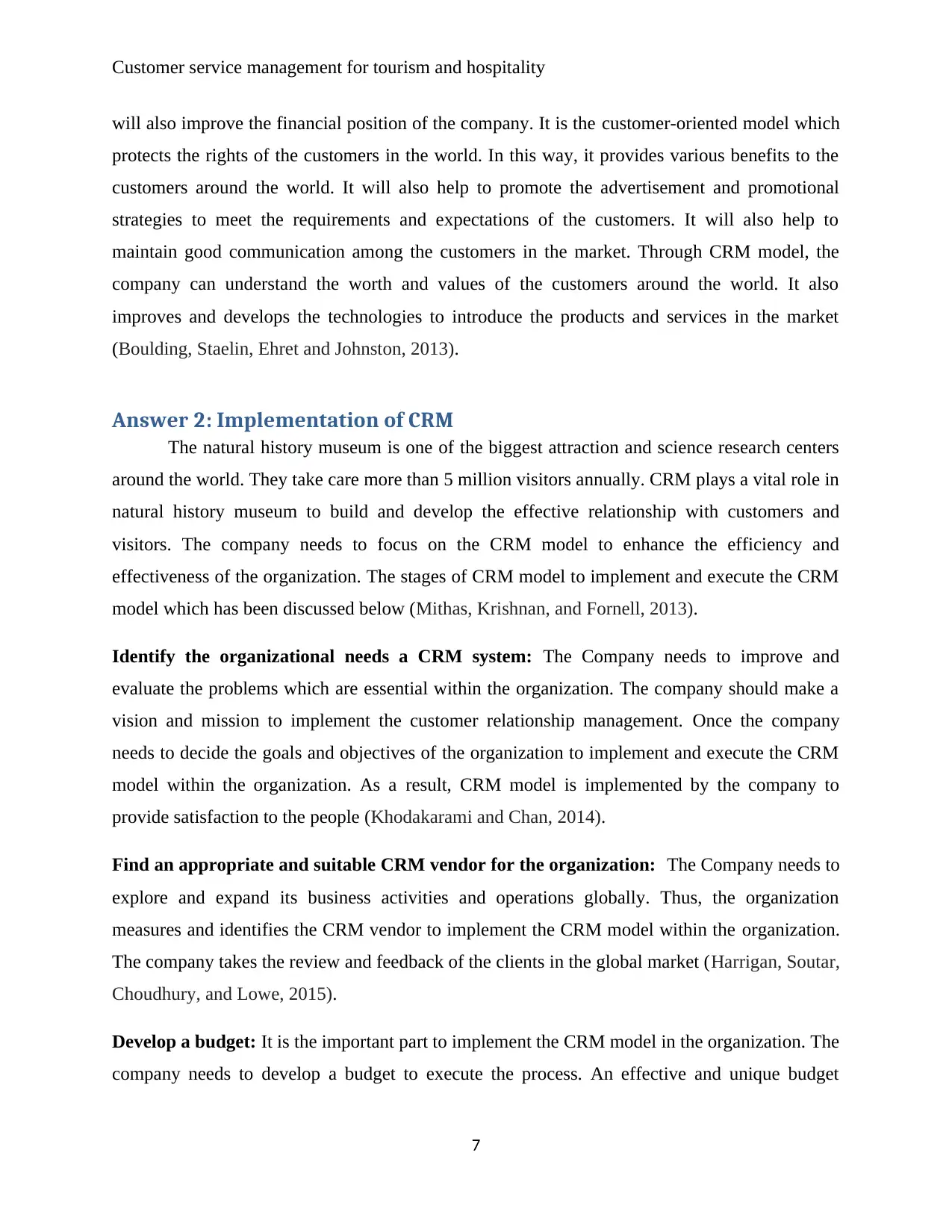
Customer service management for tourism and hospitality
will also improve the financial position of the company. It is the customer-oriented model which
protects the rights of the customers in the world. In this way, it provides various benefits to the
customers around the world. It will also help to promote the advertisement and promotional
strategies to meet the requirements and expectations of the customers. It will also help to
maintain good communication among the customers in the market. Through CRM model, the
company can understand the worth and values of the customers around the world. It also
improves and develops the technologies to introduce the products and services in the market
(Boulding, Staelin, Ehret and Johnston, 2013).
Answer 2: Implementation of CRM
The natural history museum is one of the biggest attraction and science research centers
around the world. They take care more than 5 million visitors annually. CRM plays a vital role in
natural history museum to build and develop the effective relationship with customers and
visitors. The company needs to focus on the CRM model to enhance the efficiency and
effectiveness of the organization. The stages of CRM model to implement and execute the CRM
model which has been discussed below (Mithas, Krishnan, and Fornell, 2013).
Identify the organizational needs a CRM system: The Company needs to improve and
evaluate the problems which are essential within the organization. The company should make a
vision and mission to implement the customer relationship management. Once the company
needs to decide the goals and objectives of the organization to implement and execute the CRM
model within the organization. As a result, CRM model is implemented by the company to
provide satisfaction to the people (Khodakarami and Chan, 2014).
Find an appropriate and suitable CRM vendor for the organization: The Company needs to
explore and expand its business activities and operations globally. Thus, the organization
measures and identifies the CRM vendor to implement the CRM model within the organization.
The company takes the review and feedback of the clients in the global market (Harrigan, Soutar,
Choudhury, and Lowe, 2015).
Develop a budget: It is the important part to implement the CRM model in the organization. The
company needs to develop a budget to execute the process. An effective and unique budget
7
will also improve the financial position of the company. It is the customer-oriented model which
protects the rights of the customers in the world. In this way, it provides various benefits to the
customers around the world. It will also help to promote the advertisement and promotional
strategies to meet the requirements and expectations of the customers. It will also help to
maintain good communication among the customers in the market. Through CRM model, the
company can understand the worth and values of the customers around the world. It also
improves and develops the technologies to introduce the products and services in the market
(Boulding, Staelin, Ehret and Johnston, 2013).
Answer 2: Implementation of CRM
The natural history museum is one of the biggest attraction and science research centers
around the world. They take care more than 5 million visitors annually. CRM plays a vital role in
natural history museum to build and develop the effective relationship with customers and
visitors. The company needs to focus on the CRM model to enhance the efficiency and
effectiveness of the organization. The stages of CRM model to implement and execute the CRM
model which has been discussed below (Mithas, Krishnan, and Fornell, 2013).
Identify the organizational needs a CRM system: The Company needs to improve and
evaluate the problems which are essential within the organization. The company should make a
vision and mission to implement the customer relationship management. Once the company
needs to decide the goals and objectives of the organization to implement and execute the CRM
model within the organization. As a result, CRM model is implemented by the company to
provide satisfaction to the people (Khodakarami and Chan, 2014).
Find an appropriate and suitable CRM vendor for the organization: The Company needs to
explore and expand its business activities and operations globally. Thus, the organization
measures and identifies the CRM vendor to implement the CRM model within the organization.
The company takes the review and feedback of the clients in the global market (Harrigan, Soutar,
Choudhury, and Lowe, 2015).
Develop a budget: It is the important part to implement the CRM model in the organization. The
company needs to develop a budget to execute the process. An effective and unique budget
7
Paraphrase This Document
Need a fresh take? Get an instant paraphrase of this document with our AI Paraphraser
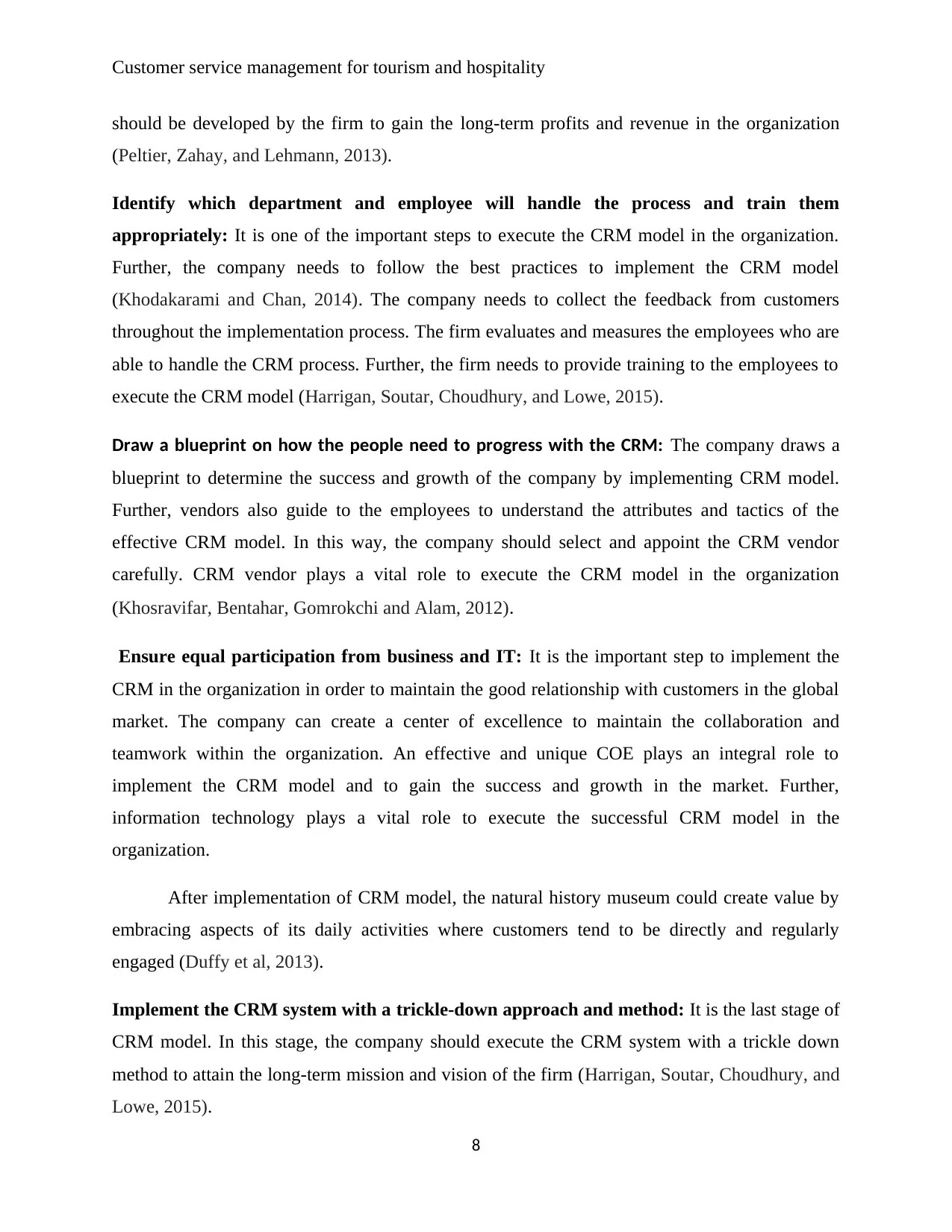
Customer service management for tourism and hospitality
should be developed by the firm to gain the long-term profits and revenue in the organization
(Peltier, Zahay, and Lehmann, 2013).
Identify which department and employee will handle the process and train them
appropriately: It is one of the important steps to execute the CRM model in the organization.
Further, the company needs to follow the best practices to implement the CRM model
(Khodakarami and Chan, 2014). The company needs to collect the feedback from customers
throughout the implementation process. The firm evaluates and measures the employees who are
able to handle the CRM process. Further, the firm needs to provide training to the employees to
execute the CRM model (Harrigan, Soutar, Choudhury, and Lowe, 2015).
Draw a blueprint on how the people need to progress with the CRM: The company draws a
blueprint to determine the success and growth of the company by implementing CRM model.
Further, vendors also guide to the employees to understand the attributes and tactics of the
effective CRM model. In this way, the company should select and appoint the CRM vendor
carefully. CRM vendor plays a vital role to execute the CRM model in the organization
(Khosravifar, Bentahar, Gomrokchi and Alam, 2012).
Ensure equal participation from business and IT: It is the important step to implement the
CRM in the organization in order to maintain the good relationship with customers in the global
market. The company can create a center of excellence to maintain the collaboration and
teamwork within the organization. An effective and unique COE plays an integral role to
implement the CRM model and to gain the success and growth in the market. Further,
information technology plays a vital role to execute the successful CRM model in the
organization.
After implementation of CRM model, the natural history museum could create value by
embracing aspects of its daily activities where customers tend to be directly and regularly
engaged (Duffy et al, 2013).
Implement the CRM system with a trickle-down approach and method: It is the last stage of
CRM model. In this stage, the company should execute the CRM system with a trickle down
method to attain the long-term mission and vision of the firm (Harrigan, Soutar, Choudhury, and
Lowe, 2015).
8
should be developed by the firm to gain the long-term profits and revenue in the organization
(Peltier, Zahay, and Lehmann, 2013).
Identify which department and employee will handle the process and train them
appropriately: It is one of the important steps to execute the CRM model in the organization.
Further, the company needs to follow the best practices to implement the CRM model
(Khodakarami and Chan, 2014). The company needs to collect the feedback from customers
throughout the implementation process. The firm evaluates and measures the employees who are
able to handle the CRM process. Further, the firm needs to provide training to the employees to
execute the CRM model (Harrigan, Soutar, Choudhury, and Lowe, 2015).
Draw a blueprint on how the people need to progress with the CRM: The company draws a
blueprint to determine the success and growth of the company by implementing CRM model.
Further, vendors also guide to the employees to understand the attributes and tactics of the
effective CRM model. In this way, the company should select and appoint the CRM vendor
carefully. CRM vendor plays a vital role to execute the CRM model in the organization
(Khosravifar, Bentahar, Gomrokchi and Alam, 2012).
Ensure equal participation from business and IT: It is the important step to implement the
CRM in the organization in order to maintain the good relationship with customers in the global
market. The company can create a center of excellence to maintain the collaboration and
teamwork within the organization. An effective and unique COE plays an integral role to
implement the CRM model and to gain the success and growth in the market. Further,
information technology plays a vital role to execute the successful CRM model in the
organization.
After implementation of CRM model, the natural history museum could create value by
embracing aspects of its daily activities where customers tend to be directly and regularly
engaged (Duffy et al, 2013).
Implement the CRM system with a trickle-down approach and method: It is the last stage of
CRM model. In this stage, the company should execute the CRM system with a trickle down
method to attain the long-term mission and vision of the firm (Harrigan, Soutar, Choudhury, and
Lowe, 2015).
8
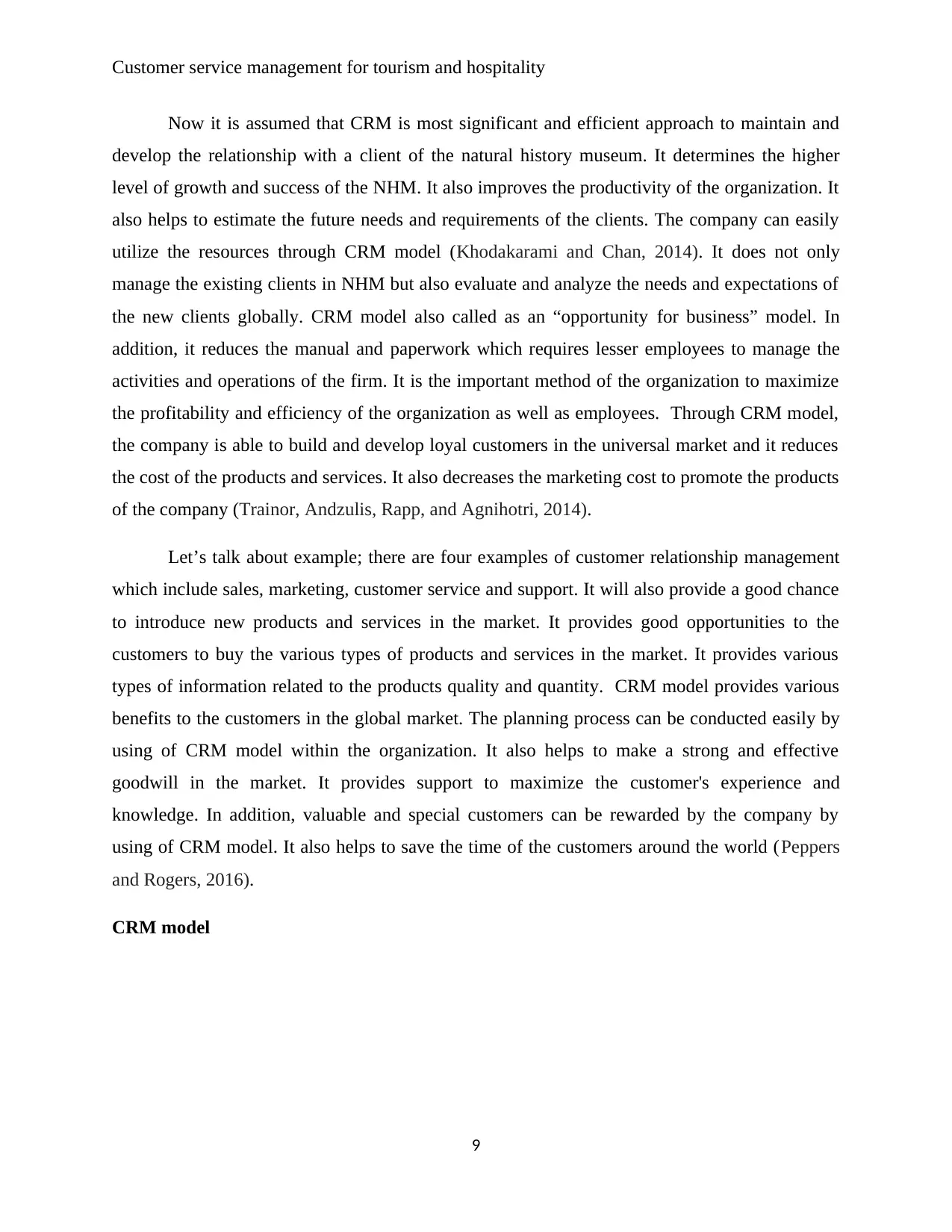
Customer service management for tourism and hospitality
Now it is assumed that CRM is most significant and efficient approach to maintain and
develop the relationship with a client of the natural history museum. It determines the higher
level of growth and success of the NHM. It also improves the productivity of the organization. It
also helps to estimate the future needs and requirements of the clients. The company can easily
utilize the resources through CRM model (Khodakarami and Chan, 2014). It does not only
manage the existing clients in NHM but also evaluate and analyze the needs and expectations of
the new clients globally. CRM model also called as an “opportunity for business” model. In
addition, it reduces the manual and paperwork which requires lesser employees to manage the
activities and operations of the firm. It is the important method of the organization to maximize
the profitability and efficiency of the organization as well as employees. Through CRM model,
the company is able to build and develop loyal customers in the universal market and it reduces
the cost of the products and services. It also decreases the marketing cost to promote the products
of the company (Trainor, Andzulis, Rapp, and Agnihotri, 2014).
Let’s talk about example; there are four examples of customer relationship management
which include sales, marketing, customer service and support. It will also provide a good chance
to introduce new products and services in the market. It provides good opportunities to the
customers to buy the various types of products and services in the market. It provides various
types of information related to the products quality and quantity. CRM model provides various
benefits to the customers in the global market. The planning process can be conducted easily by
using of CRM model within the organization. It also helps to make a strong and effective
goodwill in the market. It provides support to maximize the customer's experience and
knowledge. In addition, valuable and special customers can be rewarded by the company by
using of CRM model. It also helps to save the time of the customers around the world (Peppers
and Rogers, 2016).
CRM model
9
Now it is assumed that CRM is most significant and efficient approach to maintain and
develop the relationship with a client of the natural history museum. It determines the higher
level of growth and success of the NHM. It also improves the productivity of the organization. It
also helps to estimate the future needs and requirements of the clients. The company can easily
utilize the resources through CRM model (Khodakarami and Chan, 2014). It does not only
manage the existing clients in NHM but also evaluate and analyze the needs and expectations of
the new clients globally. CRM model also called as an “opportunity for business” model. In
addition, it reduces the manual and paperwork which requires lesser employees to manage the
activities and operations of the firm. It is the important method of the organization to maximize
the profitability and efficiency of the organization as well as employees. Through CRM model,
the company is able to build and develop loyal customers in the universal market and it reduces
the cost of the products and services. It also decreases the marketing cost to promote the products
of the company (Trainor, Andzulis, Rapp, and Agnihotri, 2014).
Let’s talk about example; there are four examples of customer relationship management
which include sales, marketing, customer service and support. It will also provide a good chance
to introduce new products and services in the market. It provides good opportunities to the
customers to buy the various types of products and services in the market. It provides various
types of information related to the products quality and quantity. CRM model provides various
benefits to the customers in the global market. The planning process can be conducted easily by
using of CRM model within the organization. It also helps to make a strong and effective
goodwill in the market. It provides support to maximize the customer's experience and
knowledge. In addition, valuable and special customers can be rewarded by the company by
using of CRM model. It also helps to save the time of the customers around the world (Peppers
and Rogers, 2016).
CRM model
9
⊘ This is a preview!⊘
Do you want full access?
Subscribe today to unlock all pages.

Trusted by 1+ million students worldwide
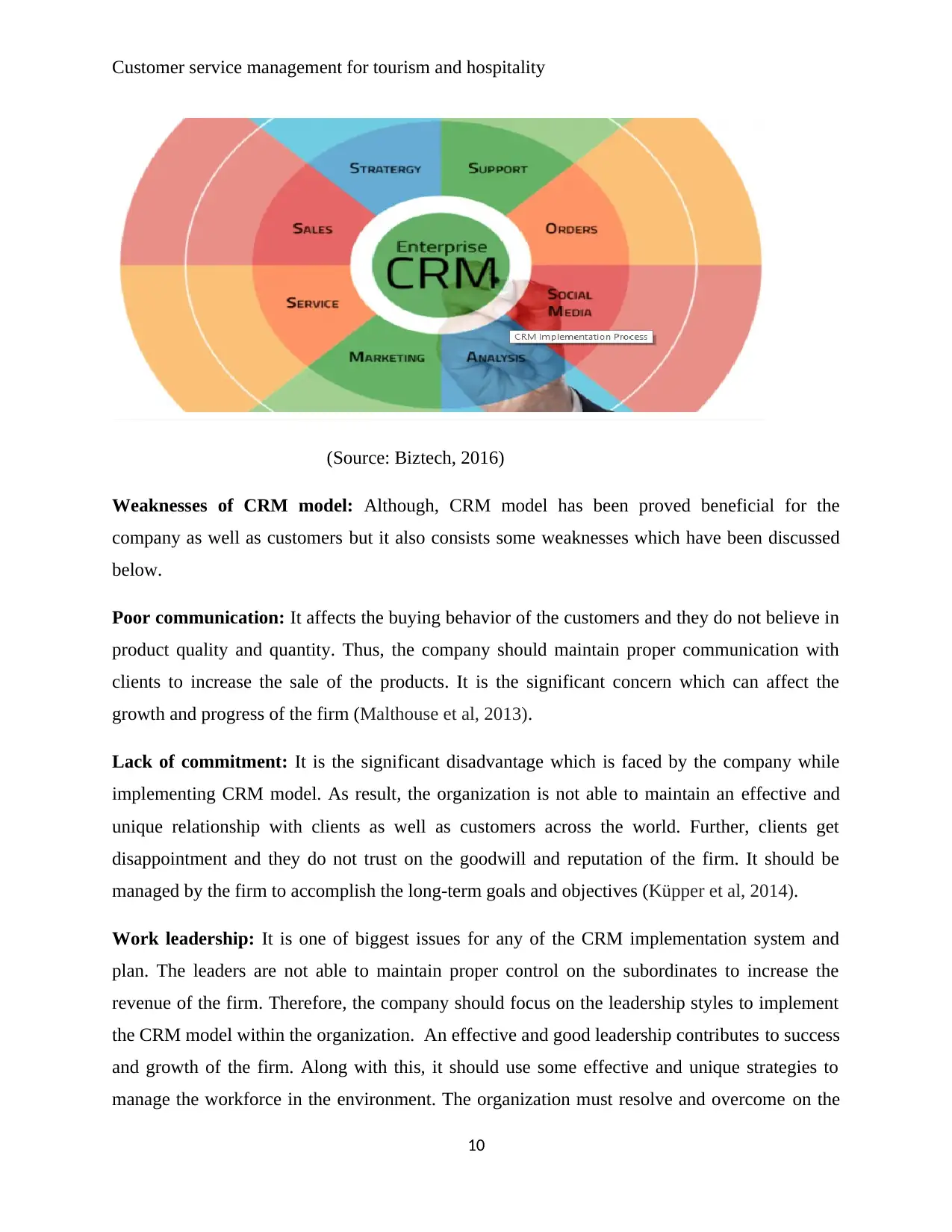
Customer service management for tourism and hospitality
(Source: Biztech, 2016)
Weaknesses of CRM model: Although, CRM model has been proved beneficial for the
company as well as customers but it also consists some weaknesses which have been discussed
below.
Poor communication: It affects the buying behavior of the customers and they do not believe in
product quality and quantity. Thus, the company should maintain proper communication with
clients to increase the sale of the products. It is the significant concern which can affect the
growth and progress of the firm (Malthouse et al, 2013).
Lack of commitment: It is the significant disadvantage which is faced by the company while
implementing CRM model. As result, the organization is not able to maintain an effective and
unique relationship with clients as well as customers across the world. Further, clients get
disappointment and they do not trust on the goodwill and reputation of the firm. It should be
managed by the firm to accomplish the long-term goals and objectives (Küpper et al, 2014).
Work leadership: It is one of biggest issues for any of the CRM implementation system and
plan. The leaders are not able to maintain proper control on the subordinates to increase the
revenue of the firm. Therefore, the company should focus on the leadership styles to implement
the CRM model within the organization. An effective and good leadership contributes to success
and growth of the firm. Along with this, it should use some effective and unique strategies to
manage the workforce in the environment. The organization must resolve and overcome on the
10
(Source: Biztech, 2016)
Weaknesses of CRM model: Although, CRM model has been proved beneficial for the
company as well as customers but it also consists some weaknesses which have been discussed
below.
Poor communication: It affects the buying behavior of the customers and they do not believe in
product quality and quantity. Thus, the company should maintain proper communication with
clients to increase the sale of the products. It is the significant concern which can affect the
growth and progress of the firm (Malthouse et al, 2013).
Lack of commitment: It is the significant disadvantage which is faced by the company while
implementing CRM model. As result, the organization is not able to maintain an effective and
unique relationship with clients as well as customers across the world. Further, clients get
disappointment and they do not trust on the goodwill and reputation of the firm. It should be
managed by the firm to accomplish the long-term goals and objectives (Küpper et al, 2014).
Work leadership: It is one of biggest issues for any of the CRM implementation system and
plan. The leaders are not able to maintain proper control on the subordinates to increase the
revenue of the firm. Therefore, the company should focus on the leadership styles to implement
the CRM model within the organization. An effective and good leadership contributes to success
and growth of the firm. Along with this, it should use some effective and unique strategies to
manage the workforce in the environment. The organization must resolve and overcome on the
10
Paraphrase This Document
Need a fresh take? Get an instant paraphrase of this document with our AI Paraphraser
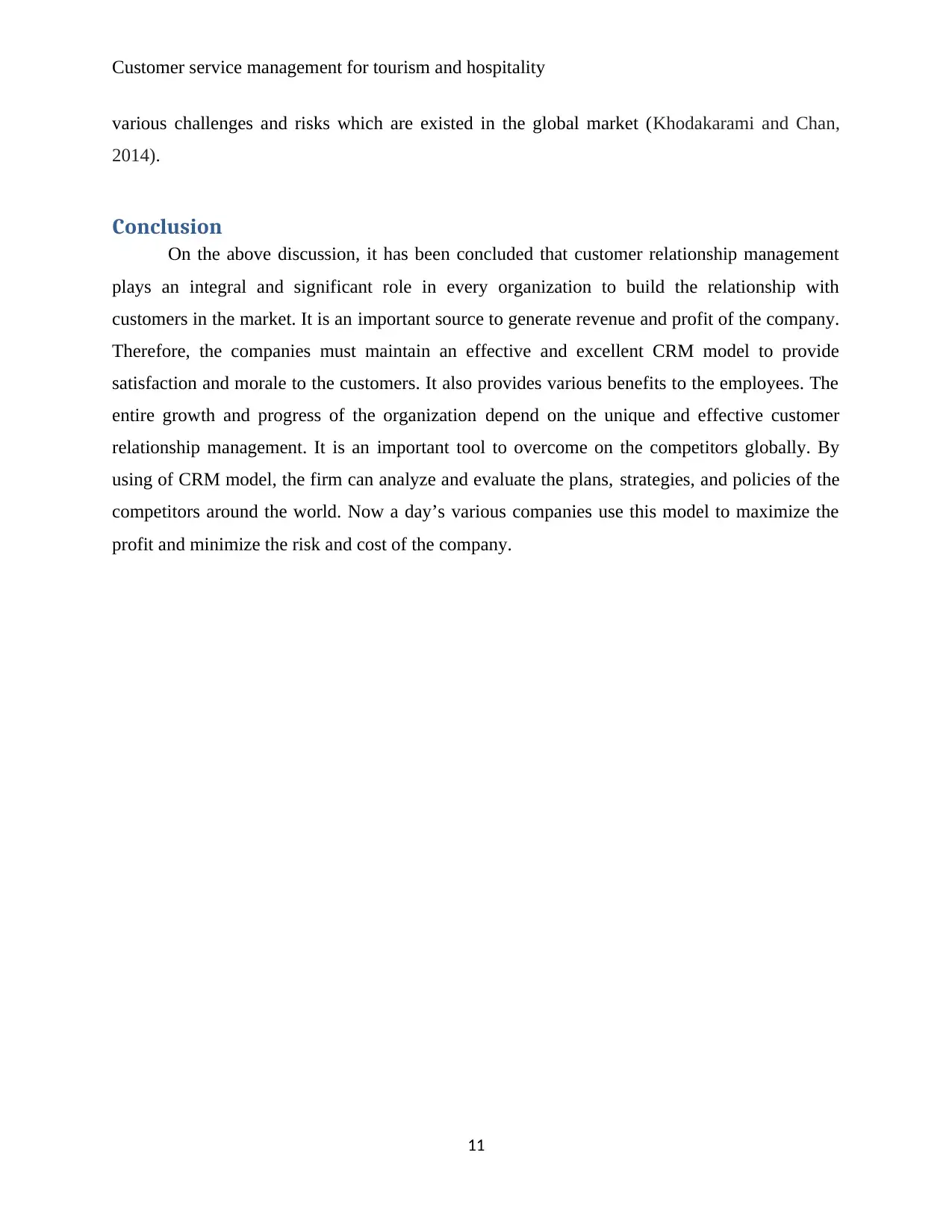
Customer service management for tourism and hospitality
various challenges and risks which are existed in the global market (Khodakarami and Chan,
2014).
Conclusion
On the above discussion, it has been concluded that customer relationship management
plays an integral and significant role in every organization to build the relationship with
customers in the market. It is an important source to generate revenue and profit of the company.
Therefore, the companies must maintain an effective and excellent CRM model to provide
satisfaction and morale to the customers. It also provides various benefits to the employees. The
entire growth and progress of the organization depend on the unique and effective customer
relationship management. It is an important tool to overcome on the competitors globally. By
using of CRM model, the firm can analyze and evaluate the plans, strategies, and policies of the
competitors around the world. Now a day’s various companies use this model to maximize the
profit and minimize the risk and cost of the company.
11
various challenges and risks which are existed in the global market (Khodakarami and Chan,
2014).
Conclusion
On the above discussion, it has been concluded that customer relationship management
plays an integral and significant role in every organization to build the relationship with
customers in the market. It is an important source to generate revenue and profit of the company.
Therefore, the companies must maintain an effective and excellent CRM model to provide
satisfaction and morale to the customers. It also provides various benefits to the employees. The
entire growth and progress of the organization depend on the unique and effective customer
relationship management. It is an important tool to overcome on the competitors globally. By
using of CRM model, the firm can analyze and evaluate the plans, strategies, and policies of the
competitors around the world. Now a day’s various companies use this model to maximize the
profit and minimize the risk and cost of the company.
11
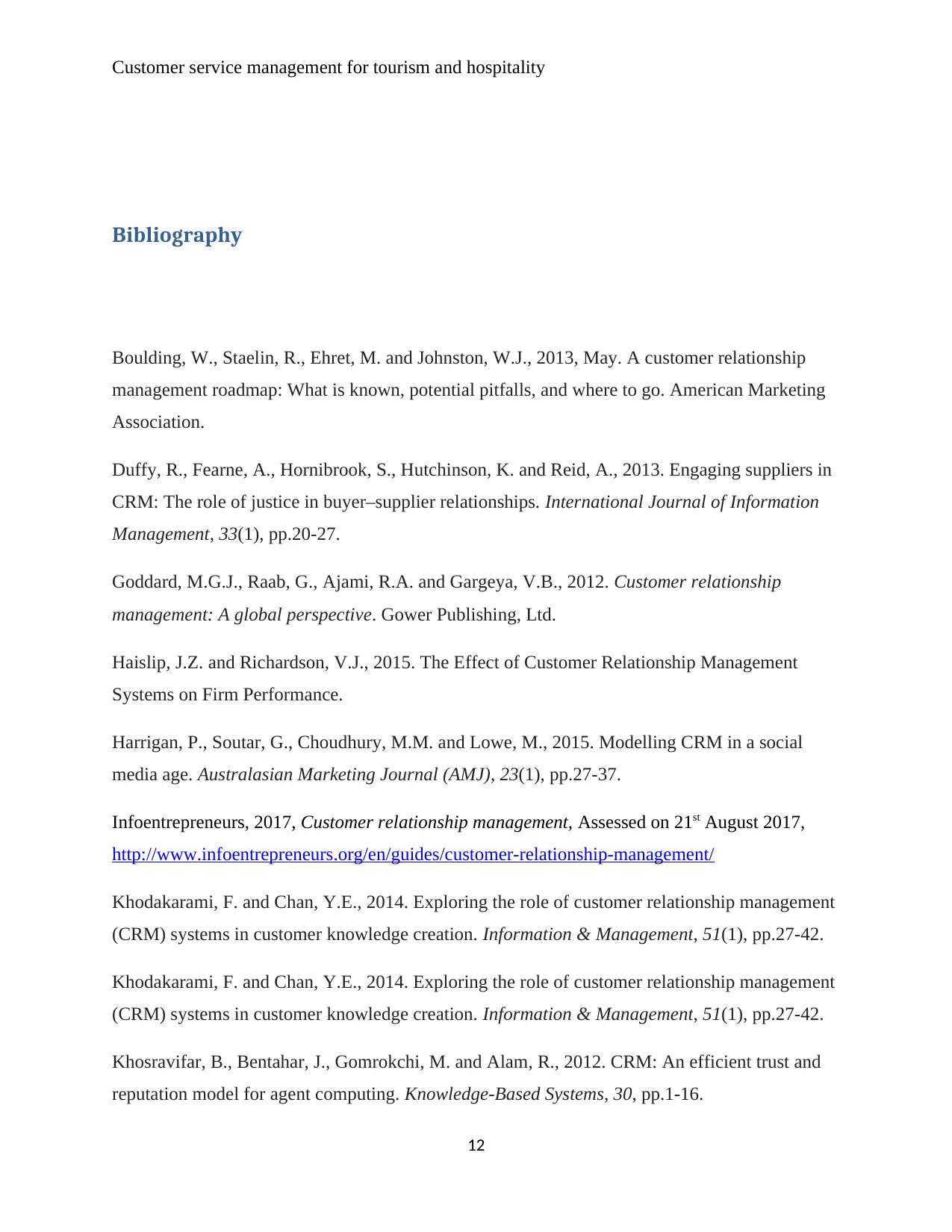
Customer service management for tourism and hospitality
Bibliography
Boulding, W., Staelin, R., Ehret, M. and Johnston, W.J., 2013, May. A customer relationship
management roadmap: What is known, potential pitfalls, and where to go. American Marketing
Association.
Duffy, R., Fearne, A., Hornibrook, S., Hutchinson, K. and Reid, A., 2013. Engaging suppliers in
CRM: The role of justice in buyer–supplier relationships. International Journal of Information
Management, 33(1), pp.20-27.
Goddard, M.G.J., Raab, G., Ajami, R.A. and Gargeya, V.B., 2012. Customer relationship
management: A global perspective. Gower Publishing, Ltd.
Haislip, J.Z. and Richardson, V.J., 2015. The Effect of Customer Relationship Management
Systems on Firm Performance.
Harrigan, P., Soutar, G., Choudhury, M.M. and Lowe, M., 2015. Modelling CRM in a social
media age. Australasian Marketing Journal (AMJ), 23(1), pp.27-37.
Infoentrepreneurs, 2017, Customer relationship management, Assessed on 21st August 2017,
http://www.infoentrepreneurs.org/en/guides/customer-relationship-management/
Khodakarami, F. and Chan, Y.E., 2014. Exploring the role of customer relationship management
(CRM) systems in customer knowledge creation. Information & Management, 51(1), pp.27-42.
Khodakarami, F. and Chan, Y.E., 2014. Exploring the role of customer relationship management
(CRM) systems in customer knowledge creation. Information & Management, 51(1), pp.27-42.
Khosravifar, B., Bentahar, J., Gomrokchi, M. and Alam, R., 2012. CRM: An efficient trust and
reputation model for agent computing. Knowledge-Based Systems, 30, pp.1-16.
12
Bibliography
Boulding, W., Staelin, R., Ehret, M. and Johnston, W.J., 2013, May. A customer relationship
management roadmap: What is known, potential pitfalls, and where to go. American Marketing
Association.
Duffy, R., Fearne, A., Hornibrook, S., Hutchinson, K. and Reid, A., 2013. Engaging suppliers in
CRM: The role of justice in buyer–supplier relationships. International Journal of Information
Management, 33(1), pp.20-27.
Goddard, M.G.J., Raab, G., Ajami, R.A. and Gargeya, V.B., 2012. Customer relationship
management: A global perspective. Gower Publishing, Ltd.
Haislip, J.Z. and Richardson, V.J., 2015. The Effect of Customer Relationship Management
Systems on Firm Performance.
Harrigan, P., Soutar, G., Choudhury, M.M. and Lowe, M., 2015. Modelling CRM in a social
media age. Australasian Marketing Journal (AMJ), 23(1), pp.27-37.
Infoentrepreneurs, 2017, Customer relationship management, Assessed on 21st August 2017,
http://www.infoentrepreneurs.org/en/guides/customer-relationship-management/
Khodakarami, F. and Chan, Y.E., 2014. Exploring the role of customer relationship management
(CRM) systems in customer knowledge creation. Information & Management, 51(1), pp.27-42.
Khodakarami, F. and Chan, Y.E., 2014. Exploring the role of customer relationship management
(CRM) systems in customer knowledge creation. Information & Management, 51(1), pp.27-42.
Khosravifar, B., Bentahar, J., Gomrokchi, M. and Alam, R., 2012. CRM: An efficient trust and
reputation model for agent computing. Knowledge-Based Systems, 30, pp.1-16.
12
⊘ This is a preview!⊘
Do you want full access?
Subscribe today to unlock all pages.

Trusted by 1+ million students worldwide
1 out of 14
Related Documents
Your All-in-One AI-Powered Toolkit for Academic Success.
+13062052269
info@desklib.com
Available 24*7 on WhatsApp / Email
![[object Object]](/_next/static/media/star-bottom.7253800d.svg)
Unlock your academic potential
Copyright © 2020–2025 A2Z Services. All Rights Reserved. Developed and managed by ZUCOL.





